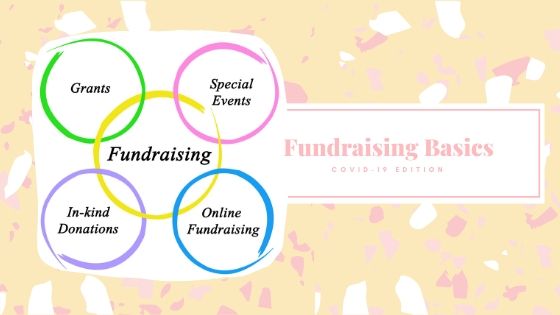In this unprecedented time, fundraising is more important than ever. Question is how do you fundraise?
My husband and I were talking the other day because, for some reason, he has an interest in how to fundraise when you are in isolation. My husband, who is not nonprofit or fundraising savvy, said, “ I guess we need to go back to the old time tel-a-thon!” He was on the right track. We need to go back to the basics.
So, with inspiration from my husband, today I’ll give you some tips on basic fundraising during a pandemic isolation.
1. Diversified Funds are Your Friend
I hope you figured out by now how important having multiple income streams are. If you were an event heavy nonprofit, you are in panic mode. If you have it built your donor database, I think it’s hitting you how important that database is right now.
So, what are you to do? Sit down and look at your income streams. Start brainstorming income streams you can modify and ones you can improve or create. Events will definitely fit into the modify category. They will need to be postponed or moved online. Reaching out to your donors and finding ways to increase your donor database may be ways to improve your fundraising efforts.
2. Revise or create your fundraising plan
The fundraising plan you put together even 90 days ago probably isn’t going to work in today’s time of isolation. Now is the time to go back and rethink your income strategies in light of current events.
If you don’t have a fundraising plan, get one. Now. Don’t wait. You need to carefully consider your options. In-person events are not an option, so your plan doesn’t need them right now. Maybe consider them for the fall but not now. Laying out your options does three things:
1. Gives You Control Over Your Fundraising Activities
Mapping out your plan for the next 90 days will give you control over your fundraising activities. You will see what you need to change, postpone, or, when appropriate, cancel.
2. Allows You to Plan in Downtime
Knowing exactly what you need to do in downtime will help focus you and as we know, focus raises more money. Which brings me to point number three.
3. Raises More Money
Understanding how you will modify your plans will make you more cost effective. Cost effectiveness always brings in more money. It will also focus you on those things that you will get a return on investment and that will allow you to move your organization forward.
3. Don’t Stop Fundraising
However you decide to fundraise, the key is to keep fundraising. Your message has to change. You have to show empathy but you don’t stop fundraising. If you go silent in the middle of crisis, people will forget you exist and when the smoke clears and the dust settles, people will wonder where you were. Organizations who stop fundraising during hard times bring in zero dollars and it hurts overall giving. Case in point.
“During the Financial Crisis of 2008, hundreds of organizations cut back or cancelled their direct mail fundraising. (At that time, digital fundraising was still quite small.) They did so because response rates had dropped for many mailers. That, coupled with the general sense of doom and panic that pervaded public discussion at the time made many people feel that there was no point investing in direct mail, as it was doomed to fail anyway. As a result, overall fundraising in the US dropped — for the first time in many decades.
But here’s the thing. Many other organizations kept on mailing. And they did well. They tested and learned, and found the messaging that worked best in the difficult environment. Some of them had record-breaking growth while the industry as a whole suffered. (It helped that mailboxes were much emptier than normal, cutting down on competition for those courageous mailers.),” Sean Trainer of Moceanic said in a recent webinar.
Whether you are using direct mail, events, grants, or other sources of income, the point is don’t stop fundraising. You can’t afford to.
What Specifically are Fundraising Basics?
Individual donors are the very basics. How can you increase your donor base? Start with your Board and move out. Ask your Board for two people that they think would be open to your mission. Write a personal letter introducing yourself and your organization. Ask if they would like more information on your organization.
Put a lead magnet on your website. Offer something valuable in exchange for email addresses. If you can relate something to COVID-19 right now, then put that information out.
Turn your Facebook fans into donors. Try a fundraiser on Facebook or advertise your lead magnet. Try GiveButter for Facebook fundraisers. They have a free account.
Get grant ready during this time. What do you need to work on to be ready to apply for grants in 30, 60, 90 days?
Update or create your donation page. You can do this by adding a page to your website or sign up for free accounts at Givebox or GiveLively.
Get creative. Brainstorm ways to raise money under your current situation. Ask your Board for help.
What are you doing to raise money for your organization during the pandemic? Tell me on Facebook.


 Most nonprofit leaders lay awake at night trying to figure out how to fund their mission.
Hi! I'm Alesha.
I teach sustainable fundraising in a way that they can take action today so they can serve their clients.
I can help you move from just getting started funding your new nonprofit to gaining confidence in your fundraising and building relationships to knowing what works for your organization and looking at the infinite game when it comes to funding. I’ve worked with nonprofit Founders and written the book I HAVE MY 501(C)3! NOW WHAT?!? Your Blueprint to Starting Your Nonprofit Without Being the Sole Funder that lays the foundations for funding in a new nonprofit.
I’ve worked in Development (Fundraising) Departments in large organizations and I know the no cost, low-cost methods they use to bring in funding. I bring those sound strategies to the nonprofits I serve.
Most nonprofit leaders lay awake at night trying to figure out how to fund their mission.
Hi! I'm Alesha.
I teach sustainable fundraising in a way that they can take action today so they can serve their clients.
I can help you move from just getting started funding your new nonprofit to gaining confidence in your fundraising and building relationships to knowing what works for your organization and looking at the infinite game when it comes to funding. I’ve worked with nonprofit Founders and written the book I HAVE MY 501(C)3! NOW WHAT?!? Your Blueprint to Starting Your Nonprofit Without Being the Sole Funder that lays the foundations for funding in a new nonprofit.
I’ve worked in Development (Fundraising) Departments in large organizations and I know the no cost, low-cost methods they use to bring in funding. I bring those sound strategies to the nonprofits I serve.